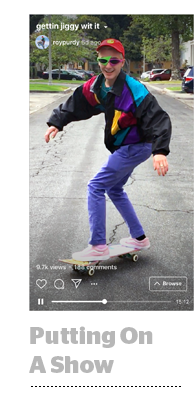
Instagram dropped its answer to YouTube on Wednesday, and the timing couldn’t be riper.
Ad spending across the top 70 YouTube channels is essentially flat, with only a 0.2% increase this year, according to ad sales intelligence business MediaRadar.
Why? Marketers are increasingly worried about their brand reps on YouTube, said MediaRadar CEO and co-founder Todd Krizelman.
Instagram’s IGTV app could be the antidote, or at least a brand-safe option for marketers to diversify their video spend. With IGTV’s “shows” lasting up to an hour, it seems like prime real estate for future advertisers – when the platform decides to monetize, of course.
IGTV is linked to a user’s Instagram accounts and provides access to a multichannel system that displays long-form vertical video content. Like a traditional TV, IGTV immediately presents the user with content as soon as it’s turned on.
“How and what we watch is changing, but the current video experience hasn’t evolved,” Instagram spokesperson Jessica Gibby told AdExchanger. “Instead of being an old format, it’s video built for your phone – full-screen and vertical.”
Recent controversies have caused marketers to rethink their YouTube investments.
In April, CNN discovered YouTube had run ads from hundreds of brands across white nationalist, Nazi and North Korean conspiracy videos. Popular brands like Netflix, Facebook, Amazon and LinkedIn could have unintentionally funded some of these extremist channels by paying for their ads to appear on YouTube.
Immediately after the report, Under Armour announced it was “pausing its advertising buy” on the platform, CNN reported.
With YouTube in the dog house, agencies seem cautiously optimistic about IGTV’s sudden presence. Even so, it’ll take time for consumers and advertisers to build trust in the platform.
For example, what about monetization? Facebook has been “light on advertising opportunity specifics,” said Joshua Lowcock, global brand safety officer at UM.
Instagram clearly sees its popular creators, such as King Bach and LaurDIY, as key components of its audience-building strategy, and it’s implicitly understood that in doing so influencers will also play a critical role in Instagram’s plans to monetize IGTV. For now, however, there are no advertising options.
But even when advertising does become available on IGTV, which will likely happen at some point, Instagram’s video offering isn’t necessarily a brand safety oasis.
“With IGTV, like YouTube, anyone can be a creator,” Lowcock said. “Missing in Facebook’s announcements are details on monetization thresholds, statements on community and advertising standards, advertiser controls and how Facebook plans to work with third-party verification providers.”
All are areas where YouTube is trying to improve to make it a better place for advertisers, Lowcock added.
Despite the lack of an ad opportunity on IGTV now, however, it does appear Instagram is already preparing one – and looking to prove itself as a safe option for marketers, said Noah Mallin, head of experience, content and sponsorships at Wavemaker.
Although influencers have three primary platforms – YouTube, Instagram and Twitch – only one, Instagram, is a place where “video isn’t really the primary thing,” Mallin said.
“Facebook [sees IGTV] as a way to organize video in a more cohesive way,” he said. “I think they’re going to try to make it easier and safer for brands to work with influencers, even on the back end.”
IGTV is already positioning itself carefully, perhaps in light of YouTube’s foibles. Though Instagram isn’t running ads over its IGTV content yet, Gibby told AdExchanger the company will “be exploring and testing ways to help creators monetize after launch.” To start, creators with marketing deals can add advertising links on their IGTV pages.
On the broadest level, all content on IGTV will have to adhere to Instagram’s community guidelines, and “proactive and reactive systems” will help remove inappropriate content. In addition to having its community flag content that seems to violate Instagram’s standards, a global operations team reviews all content that’s reported on Instagram.
This post was syndicated from Ad Exchanger.

More Stories
PEDIGREE® helps pet parents spot the porkies with new Lie Detector
Revolving Door Round-Up: Antonia Hylton and Elise Jordan to Co-Host The Weekend
Kiwi Mobile’s latest campaign walks the talk